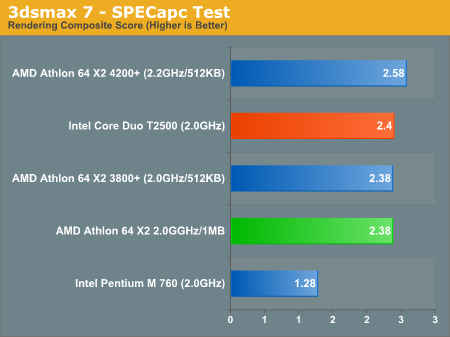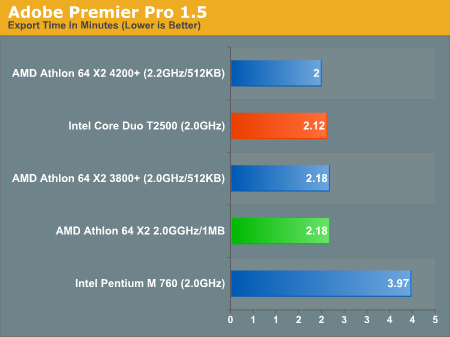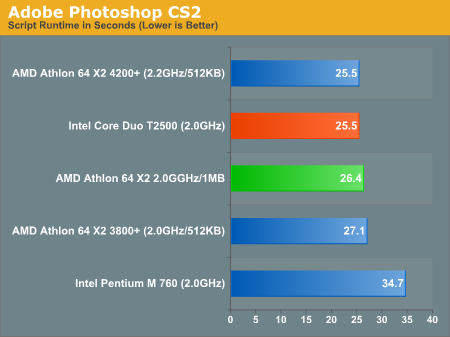Intel Core Duo (Yonah) Performance Preview - Part II
by Anand Lal Shimpi on December 19, 2005 12:55 PM EST- Posted in
- CPUs
Professional Application Performance with 3dsmax, Adobe Premier and Photoshop
We start off our page on professional application performance with an updated version of the SPECapc 3dsmax test, updated for version 7 of the application. The scenes being rendered haven't actually changed, but the reference numbers used to compute the composite scores have, so these scores aren't directly comparable to results from earlier SPECapc tests.
Compared to the Athlon 64 X2, the Core Duo comes out on top, but by a very small margin - once again we're faced with a virtual tie.
The breakdown of the rendering composite score can be found below; the scores in the table are render time in seconds, lower numbers are better:
Moving onto Adobe Premier Pro 1.5, this test is actually one that is used by Intel to showcase the performance of the Pentium 4 processor. With the Pentium 4 absent from this comparison, we were curious as to how it compared to the Core Duo and the Pentium M.
As with virtually any media encoding performance, dual-core processors do extremely well, and this case is no different with the Core Duo T2500 seriously outpacing the Pentium M 760.
The Core Duo T2500 is also able to complete the export process in about 97% of the time of the Athlon 64 X2, which once again ends up being borderline negligible for this test, but it is important to note that this advantage comes without the aid of an on-die memory controller.
Our final test is the only other Intel-supplied test in the suite. This one used to showcase the Pentium 4's performance under Adobe Photoshop CS2 by measuring the time that it takes to run a few filters and resize/export images. The script itself is fairly realistic; however, with Photoshop filters, it is easy to favor one architecture over another, so by no means are these numbers intended to be conclusive of Photoshop CS2 performance.
We start off our page on professional application performance with an updated version of the SPECapc 3dsmax test, updated for version 7 of the application. The scenes being rendered haven't actually changed, but the reference numbers used to compute the composite scores have, so these scores aren't directly comparable to results from earlier SPECapc tests.

Compared to the Athlon 64 X2, the Core Duo comes out on top, but by a very small margin - once again we're faced with a virtual tie.
The breakdown of the rendering composite score can be found below; the scores in the table are render time in seconds, lower numbers are better:
| SPECapc 3dsmax 7 Breakdown | AMD Athlon 64 X2 4200+ | AMD Athlon 64 X2 3800+ | AMD Athlon 64 X2 2.0GHz/1MB | Intel Core Duo T2500 | Intel Pentium M 760 |
| 3dsmax 5 rays | 15.406 | 15.829 | 16.109 | 14.297 | 25.246 |
| CBALLS2 | 20.125 | 22.281 | 22.094 | 21.187 | 42.201 |
| SinglePipe2 | 92.844 | 101.906 | 101.922 | 107.359 | 203.492 |
| UnderWater | 142.938 | 157.219 | 156.203 | 169.188 | 316.055 |
Moving onto Adobe Premier Pro 1.5, this test is actually one that is used by Intel to showcase the performance of the Pentium 4 processor. With the Pentium 4 absent from this comparison, we were curious as to how it compared to the Core Duo and the Pentium M.

As with virtually any media encoding performance, dual-core processors do extremely well, and this case is no different with the Core Duo T2500 seriously outpacing the Pentium M 760.
The Core Duo T2500 is also able to complete the export process in about 97% of the time of the Athlon 64 X2, which once again ends up being borderline negligible for this test, but it is important to note that this advantage comes without the aid of an on-die memory controller.
Our final test is the only other Intel-supplied test in the suite. This one used to showcase the Pentium 4's performance under Adobe Photoshop CS2 by measuring the time that it takes to run a few filters and resize/export images. The script itself is fairly realistic; however, with Photoshop filters, it is easy to favor one architecture over another, so by no means are these numbers intended to be conclusive of Photoshop CS2 performance.

Overall System Performance using WorldBench 5
Media Encoding Performance with DVD Shrink, WME, Quicktime and iTunes










103 Comments
View All Comments
vailr - Monday, December 19, 2005 - link
Re: Chipset Drivers used in the review:nForce4 6.66
Intel 7.0.0.25
Check here: http://www.fdrsoft.fr.fm/">http://www.fdrsoft.fr.fm/
Intel Version 7.2.2.1006
nForce4 Version 6.70
Marlin1975 - Monday, December 19, 2005 - link
Being that DVD shrink will not be updated anymore and the creator is now part of Nero, and the Recode program. Why not use Recode?PrinceGaz - Tuesday, December 20, 2005 - link
Personally I wouldn't touch any of the compressed domain transcoders like DVD Shrink as they sacrifice quality for speed. Something like DVD Rebuilder combined with the excellent CCE SP encoder provide the best possible quality and are just as easy to use as DVD Shrink. It's nowhere near as fast as DVD Shrink, but I'll take better picture quality over saving a few minutes any day.mrred - Monday, December 19, 2005 - link
Anyone else notice that the game benches seem horribly gpu-bound? How about giving us some lower resolutions in testing?Look at FEAR in particular: X2-4200 and X2-3800 getting exactly the same score? HELLO?!?!?!? That's not a cpu-benchmark. Gimme a break.
Anemone - Tuesday, December 20, 2005 - link
Frankly I appreciate testing that shows resolutions we actually play at. Now if only we'd see 1920x1200 :)blackbrrd - Monday, December 19, 2005 - link
The games are benchmarked at 1024x768.Personally I haven't played a game below 1024x768 since I got my GF2mx four or five years ago.
Most games look horrible below 1024x768, except the games ported from consoles ;)
saratoga - Monday, December 19, 2005 - link
Yeah and above 1024 you're GPU limited. Its almost like this was a CPU review.tfranzese - Monday, December 19, 2005 - link
That's not the point. The point is to relieve the GPU so regardless of what GPUs come out a year or two from now that alieviate this bottleneck we'll have known beforehand how the CPU handles things.Further, this is a CPU preview and as such we don't care about system performance or GPU performance; that shouldn't be the focus or included in the article. Instead, every benchmark should serve the articles purpose of comparing the CPUs - GPU bound benchmarks do NOT serve that purpose and should have their resolution lowered to serve that purpose, otherwise they should not be included because what point do they serve except fluff?
tayhimself - Monday, December 19, 2005 - link
Yeah this review is horrible, just like the first Yonah review.uop - Monday, December 19, 2005 - link
I wouldn't call it horrible.There are some weak points, but it does give a good idea about how the Core Duo performs.
Mainly:
- It's not as good as the A64 when it comes to games
- FP is much improved but not there yet
The article does do a good job of reminding us that Yonah is just the dress rehersal for the real deal. Conroe is supposed to be faster, wider, and full of 64-bit goodness. Think about it - with Yonah's die size, it could be the Celeron-M in just 6 months!
If Yonah can compete with the A64, then unless AMD pull a fast one they're probably heading for the underdog position.